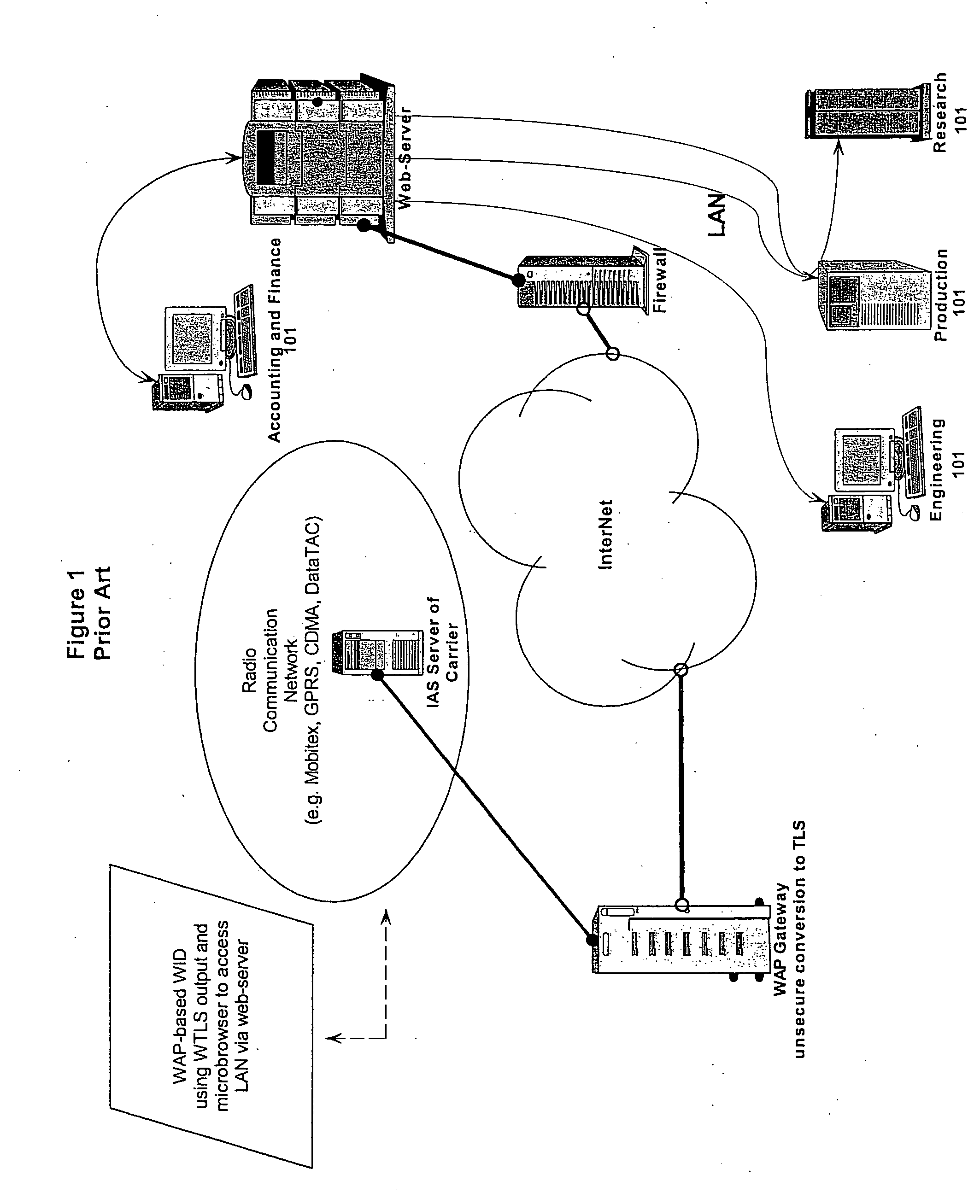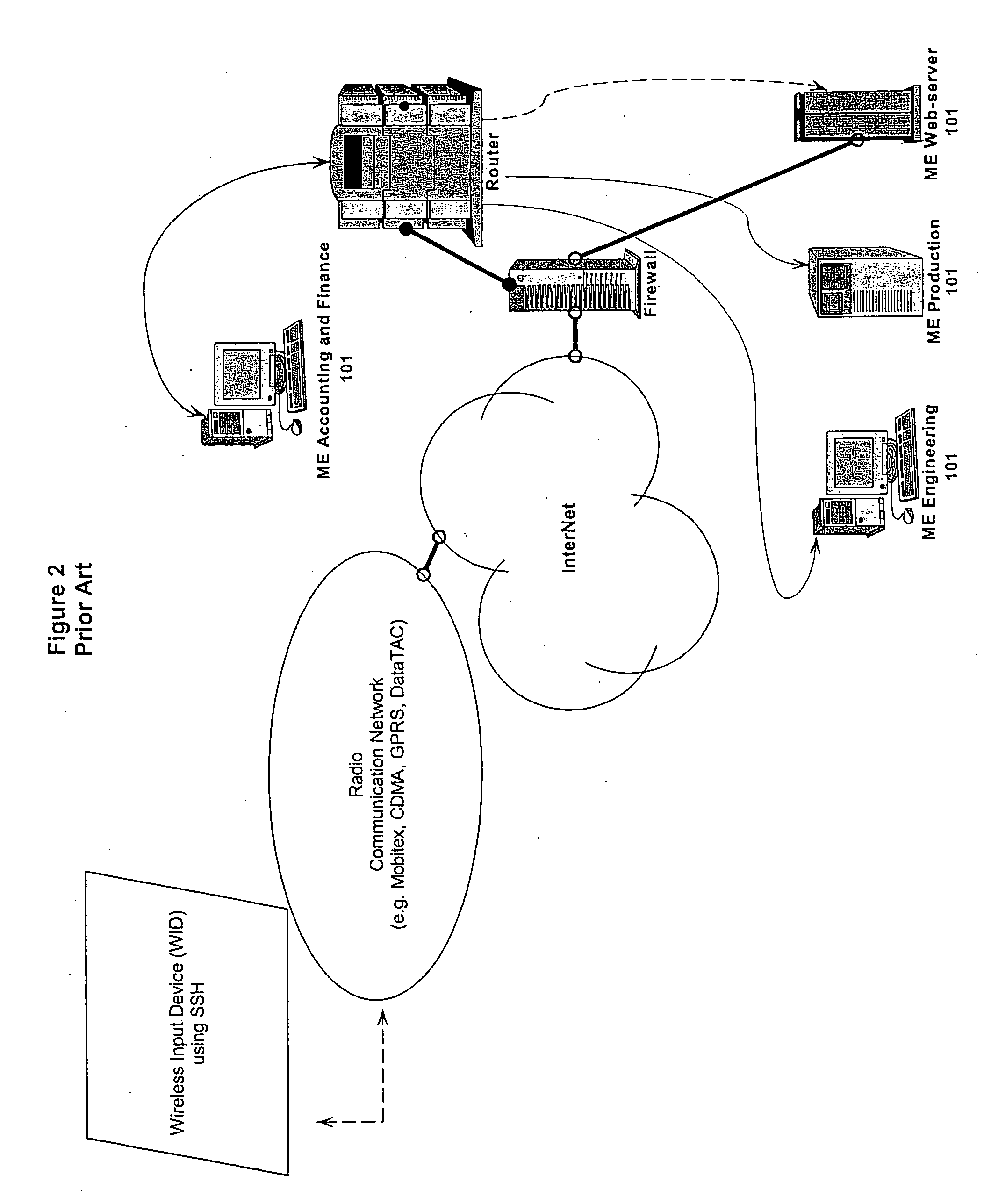Personnel capable of delivering those services are therefore in high demand and have accordingly become very expensive to maintain on staff.
Further, keeping
mission critical technical infrastructure functioning correctly in times of a
threat—one example is where a threat to a building forces the evacuation—all the critical systems and infrastructure are left inside the building while the IT staff are outside—unable to take the actions necessary to protect the network by performing administration functions including locking down core systems and users.
Unfortunately, conventional methods of wireless communication are insufficient (in both capacity and security) for use administering networks such as LANs.
These traditional approaches take
advantage of existing infrastructure to provide an inexpensive and flexible (i.e.
client WIDs need not be prepared or have
client software loaded) way to access Managed Entities, but disadvantageously increase the risk of unauthorized access to the LAN through the web-
server component of the service, a risk that is not acceptable to many businesses.
TLS was modified to address the needs of wireless users because
radio networks do not provide end-to-end security.
Since TCP / IP is not used for communication between the WAP
client and the WAP Gateway, SSL or TLS could not be used to implement the security.
However, WTLS runs on top of an unreliable
datagram service, and not a reliable transport protocol like TCP / IP, creating reliability concerns respecting message exchanges across several WTLS operations.
Although some WAP devices support multiple gateway configurations, switching between them as the users navigate from one application to another is difficult.
Use of such
system to provide LAN Admin services is necessarily risky because the web-server must have access to the LAN in order to pass Admin instructions from a WID to any server on that LAN.
However, even these newer technologies suffer a number of disadvantages.
Further, SSH is interpreted character by character causing a large volume of data transfer and work on the client WID interpreting messages sent using the SSH protocol, neither of which is desirable in the narrow-bandwidth, low capacity world of portable computing devices.
Similarly, SSL can only run on an SSL enabled WID and requires that security operations (as well as device management, and service functionality) be performed by the Managed Entity (e.g. a server on the LAN having business processes that it must run and that are thereby already consuming processor power or other
system resources) running the SSH service.
Consequently, even though some conventional SSH technologies include a
machine intermediate the firewall and the LAN, that
machine is restricted to operate as a
router rather than as a true proxy, since its purpose (even though it may be implemented with some gateway functionality) is to provide a
single point of entry through the firewall eliminating the need for a different port in the firewall to be opened for each Managed Entity requiring access to WID's outside the firewall.
Disadvantageously, in order to
handle SSH-based traffic each Managed Entity must run an SSH service.
The use of SSH to deliver OS level calls to each Managed Entity is very restrictive, limiting the variety of operations that may be executed from SSH without an additional soft agent to convert from and enhance the older style
command line interface of SSH.
However, although SSH is available as a service for Windows and
Unix servers, if the SSH service is not running on the Managed Entity at the time access by the WID is required, or the Managed Entity is not responding at all (e.g. the administrative service is required because of a runaway process, or an overloaded CPU), then there is no way to communicate with the subject Managed Entity using SSH.
And, although the SSH
Command Line interface is very powerful, it is very keystroke oriented and requires a highly-skilled operator to apply it effectively, especially using the small keyboard and screen of a typical handheld WID.
Although it is possible to write a program to run a WMI command within SSH and then use SSH to execute the program on a Managed Entity, it is very difficult to do.
And, for standard admin applications that do not
expose all functionality through the command line (e.g. accessing Windows mailbox's, rebooting a
Windows server) it is very awkward to use those applications via SSH.
Unfortunately, SSH is also an extremely dangerous service to leave running on a server since its expert user, command line access design is very powerful and unforgiving—potentially allowing essential files to be deleted and wiped from drives that may also be reformatted with no “
user friendly” warnings, backups, or means for
recovery.
Disadvantageously, whenever the need to deliver these services wirelessly arises,
Telnet and SSH are very powerful tools that can be misused to cause great disruption to the
network on which they run.
Many companies find the firewall solution too restrictive and the VPN solution too complex or costly.
Each user's
password is initially registered providing a measure of
verification, however passwords can thereafter be stolen, intercepted, accidentally revealed, or forgotten.
Typically
authentication is carried out for the User alone and not for the device, which in the context of mobile devices has the
disadvantage of permitting stolen devices to remain a threat against which there is no direct protection.
Two of those
layers (Session and Transport) are particularly important to
wireless network administrators because it is at these
layers that security problems arise when using only the generic forms of
processing, created for End Users (i.e. not Administrators) completing
business transactions, are misapplied in order to enjoy flexible access for an Administrator's tool.
Upon reception at the radio carrier's
tower, the message must be de-processed from the earlier radio network specific
processing—and then also decrypted from WTLS (for conversion to TLS), since current technologies do not permit WTLS encrypted packets to be sent over
the Internet on TCP / IP.
Conventional
remote administration technology delivers commands (e.g.
reboot), through a web-server, using these interfaces directly to the managed entity that executes without further enquiry—such that a risk of the unauthorized deliver of such commands exists.
There are currently 3 main problems associated with using wireless technology to remotely administer a computing network.
First, the need to transmit signals through open space creates a security problem because the signals are susceptible to interception.
To reduce the amount of data being transferred between a WID and its server, one conventional approach is to store more (LAN) information on the WID, which disadvantageously creates a serious security risk to the LAN in the event that the highly portable WID is stolen.
Authentication is also carried out for the User alone and not for the device, which in the context of mobile devices has the
disadvantage of permitting stolen devices to remain a threat against which there is no direct protection.
 Login to View More
Login to View More  Login to View More
Login to View More 


